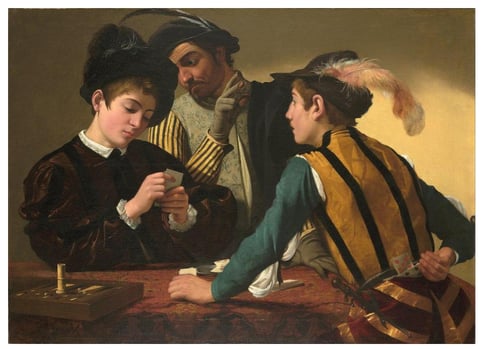
Photo caption: Caravaggio’s painting The Cardsharps offers an excellent example of narrative painting. It’s up to the viewer to decide the story. Photo courtesy of Creative Commons.
Once upon a time…
Those first words of so many stories conjure up a kaleidoscope of images. The damsel in distress. The dragon’s fiery breath. The warrior’s glistening armor. The Amazon’s fierce arrows.
They also ignite the storyteller’s imagination to just soar with ideas—ideas that we can see. When your imagination creates those stories and expresses them with pigment on canvas, we call it narrative art.
As the saying goes, “A picture is worth a thousand words.” So, even though narratives typically refer to the use of words, a picture (or painting) can engage the viewer to pen their own story from just the one frame they see on the canvas, just like Caravaggio did in the painting above.
So, What Is Narrative Art?
Simply stated, narrative painting is art that tells a story, a visual story. It causes the viewer to ask a question, to want to know more.
The “story” isn’t bound by the four sides of the canvas. It expands and moves beyond, leaving the viewer wanting to know more. It ignites the imagination of the viewer.
Think of it as if you’re capturing only one frame from a full-length movie. Just a moment of time out of the entire storyline.
This perspective allows each viewer to add their own interpretation of the rest of the story. Things that happened before and those that will happen after this one scene before them.
You, as the artist, create that scene—the scene that captures the viewers attention and stirs their own creativity.
How to Paint a Narrative Painting
Do you want to learn how to create narrative in art? The answer to this is simple. You ask questions. Questions are the key to painting a narrative piece.
You are the artist—the director of this movie. You begin with asking yourself question, like:
- What story are you telling?
- What specific scene will you be painting?
- What happens before and after?
- Which characters will you include?
- What will they be doing?
- What’s your focal point? The place you want the viewer to focus on at first glance.
- How, then, will you direct their eye to move throughout your painting?
Once you know where you’re going, you need to make sure you’re painting is open-ended. That it doesn’t become specific where you are the only one who knows the true story.
It’s almost arrogant to create art that is so strange, so elusive that viewers feel lost. Instead, you want to encourage the viewers’ imagination, to draw them into the painting, to provoke their curiosity to know more.
You want to engage their creativity as they develop their own interpretation of your piece—so much that they don’t want to part with it. Hint: Drawing them into the story is a great selling point.
All that said, it does take practice and lots of it. As we often tell our Mastery Program students, the way to develop exceptional art skills is to paint a lot. Exceptional narrative artists probably spend even more time painting and learning to paint, because pulling off a great narrative piece requires plenty of skill.
Additionally, the ability to paint narrative paintings requires you to get into the right mindset, to explore your thoughts and dreams. Dare to create your own story and paint it. Then do it again. And again.
Don’t be hard on yourself because it takes time to develop the skills of a narrative artist. This is just part of the journey to becoming a professional artist.
Final Thoughts on Narrative Art
Create your story. Be expressive. Show action and emotion in your work.
Your characters have a story to tell, but they only reveal one scene in your painting. Be sure to leave it open-ended so the viewer can ask questions and feel free to imagine their own story.
Be persistent as you continue practicing. Don’t give up! You’ll continue to grow in your art skills with each piece you create.
Join our Milan Art Community today. You’ll receive access to a number of educational resources and be inspired by this other artists from around the world.
Join today and be inspired!
Find Inspiration for Your Narrative Paintings Below!
3 Tips for Creating Painting Sources from Dreams
Drawing & Painting Inspiration: How to Powerfully Paint your Dreams
Becoming a Professional Artist: How to Create a Series

